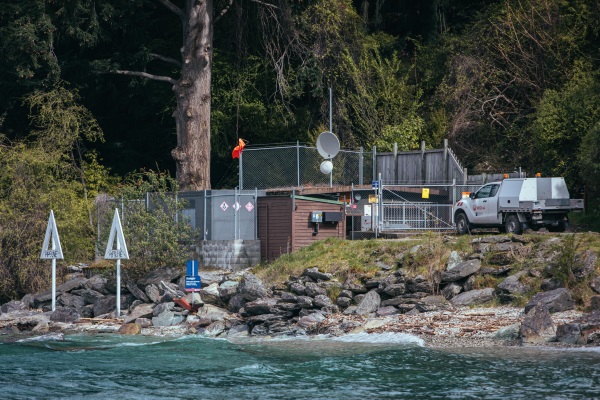Three weeks ago, Queenstown’s Two Mile water intake was being examined as the potential cause of the current cryptosporidium outbreak. While unlikely, a boil-water notice remains in place for this water supply till a protozoa barrier’s installed. However, on another occasion that intake was at the centre of a major health crisis, as PHILIP CHANDLER reports
When, in late 1984, raw sewage entered Lake Whakatipu, close to the Two Mile water supply intake pipe, about 3500 Queenstowners succumbed to vomiting and/or diarrhea.
Affecting 60 to 70% of the town’s then much-smaller population, the gastroenteritis outbreak was a shocker, particularly for locals who’d
been so proud of their pure mountain water.
What caused the epidemic was a blockage in the sewer line from Fernhill and Sunshine Bay.
A brick, entangled in tree roots, had apparently invaded the line, causing raw sewage to back-flood through an adjoining manhole and into Waterfall Creek.
That creek in turn flowed into the lake about 200m from the water supply intake below Glenorchy Rd.
Hidden in dense bush, the polluted creek was discovered by then-wildlife officer Dick Marquand, who’d been walking nearby.
Alerted, council staff then cleared the blocked sewer in a matter of hours.
The discovery came weeks after people had been turning up to doctors’ rooms and pharmacies with cases of vomiting and diarrhea.
Ironically, doctors had advised the first cases to drink plenty of water to flush out the virus.
When, of course, that didn’t work, doctors blew the whistle, and samples of the water were then sent to public health laboratories in Dunedin, on October 23.
Unfortunately, there was a postal delay when they were then sent on to the medical officer of health’s Invercargill office.
When, on November 1, it was at last proven the water supply was heavily contaminated, public health warnings were issued.
Residents and visitors were advised to boil all water, for at least the next 48 hours, and the water supply was temporarily chlorinated — council staff drained half the water from reservoirs and topped them up with chlorinated water.
Foodstuffs, party ice supplies and chemists’ medications that had all used the town’s water supply were destroyed and even ice cream-making machines, which had also used the water, were closed down.
Five elderly had to be hospitalised, but, considering so many people had dropped like flies, it was considered the town was lucky there hadn’t been worse consequences.
In particular, there’d been fears those suffering gastroenteritis could have succumbed to much-worse hepatitis A.
The then-Lake County health inspector, the late Colin Walker, also advised holiday home owners that, when they next returned to Queenstown, they should run their taps for 15 minutes to flush out the system.
By November 3, Queenstown’s water supply network had been given the ‘all-clear’.
In a Mountain Scene editorial five days later, acting editor Alan Brady wrote: ‘‘There is no question that the town had the narrowest of escapes from a disaster which could have wrecked, in one instant, the reputation it has built up over 100 years for cleanliness and beauty.
‘‘As it is, the damage is considerable.
‘‘Hundreds of local residents and an unknown number of visitors have suffered a painful and debilitating bout of gastroenteritis.
‘‘If nothing else the incident illustrates the need for the most scrupulous public health standards in a resort which relies almost totally on its
reputation for survival.
‘‘Hygiene-conscious American and Japanese visitors will not take kindly to being told that the illness which wrecked part of their vacation was caused by sewage seeping into their hotel water supply.
‘‘Queenstown’s water has had a totally clean bill of health with no bacteriological problems whatsoever since the council began pumping from the lake about five years ago.
‘‘The blocked drain which blotted that copybook was a freak incident, we were told, and could not have been predicted or prevented.
‘‘It is reassuring to know that local doctors and health inspectors were monitoring the situation from an early stage.
‘‘It is anything but reassuring to learn it took nine days to obtain an analysis of the water from Dunedin.
‘‘There seems little point in having a chlorination plant for emergency treatment of the water supply if it can take several weeks to establish that the emergency exists.
‘‘Shutting the stable door after the horse has bolted may not save Queenstown’s reputation a second time.
‘‘A permanently-chlorinated water supply may be the price the town has to pay for peace of mind.’’
Subsequently, Queenstown’s water supply was chlorinated permanently, which wards off a lot of things though not, unfortunately, crypto.




